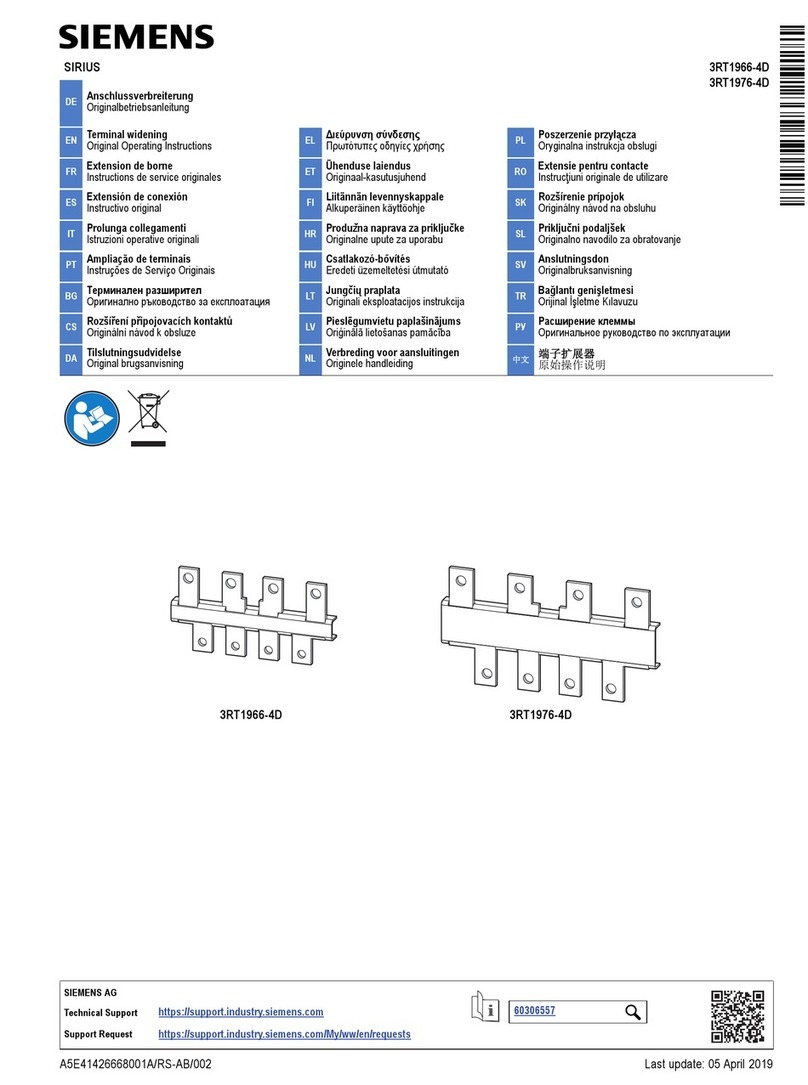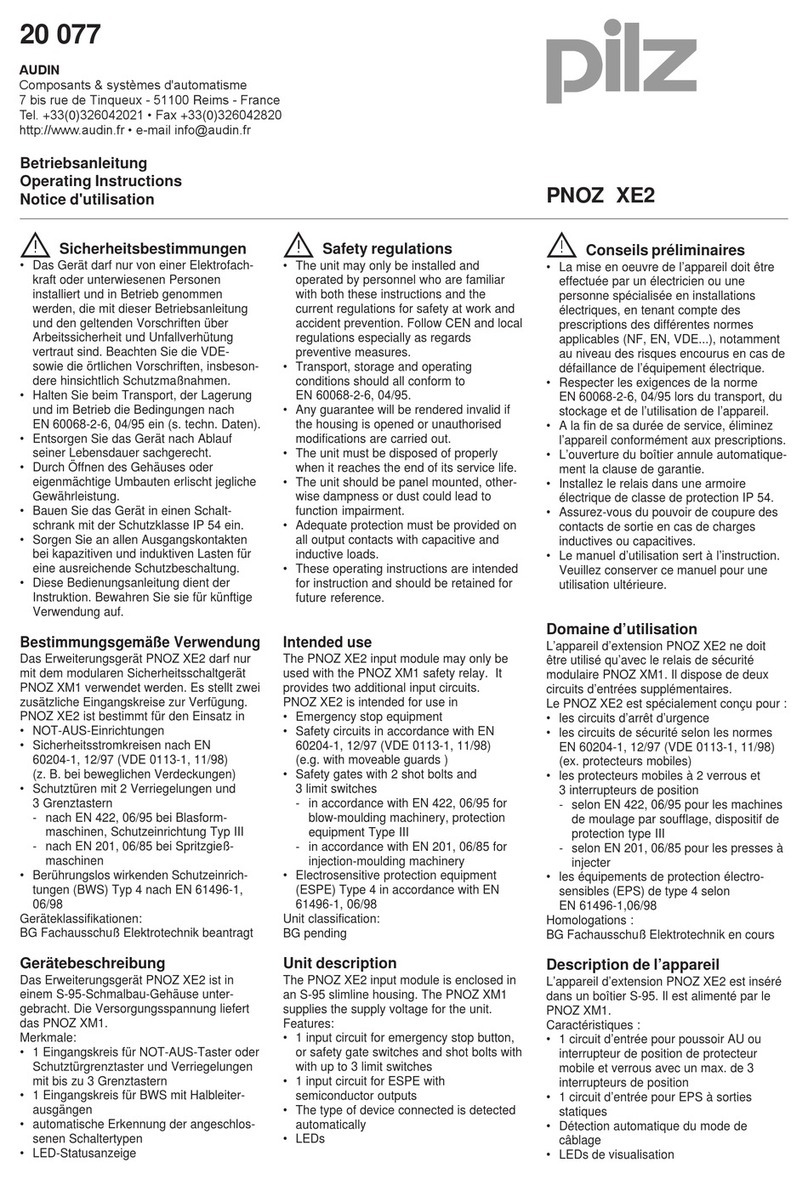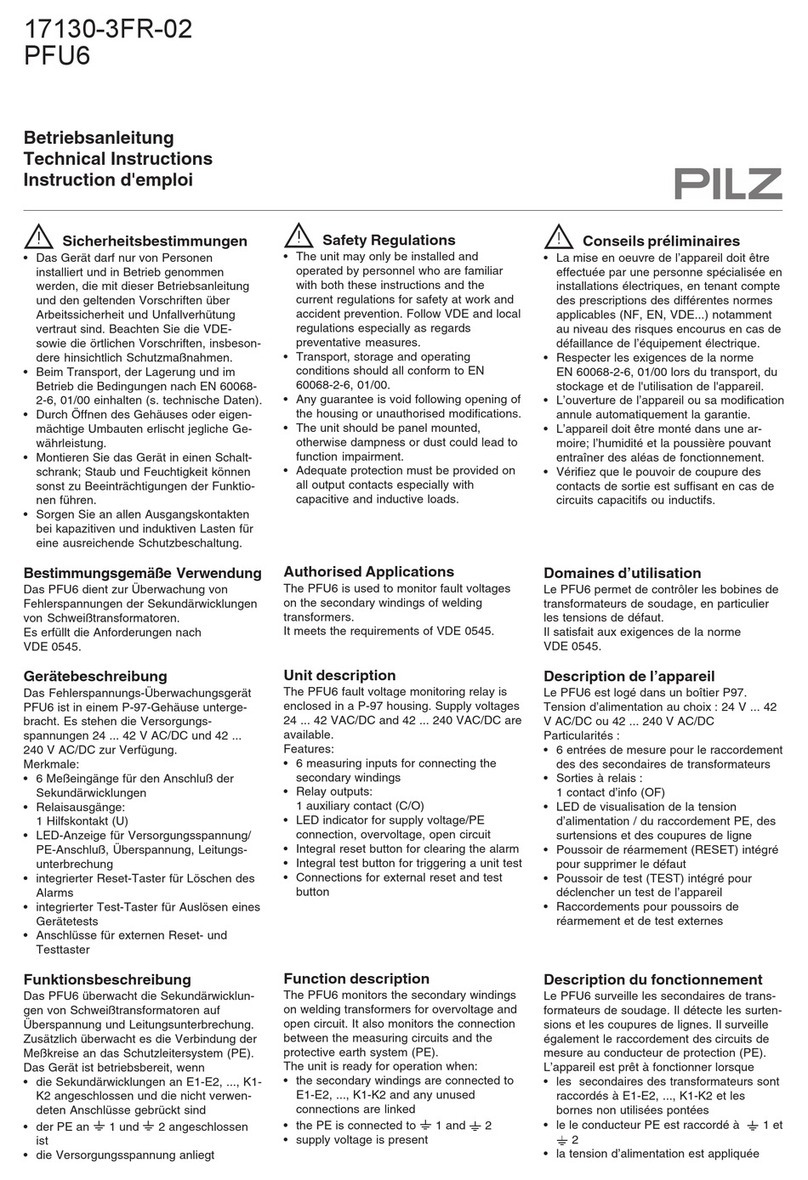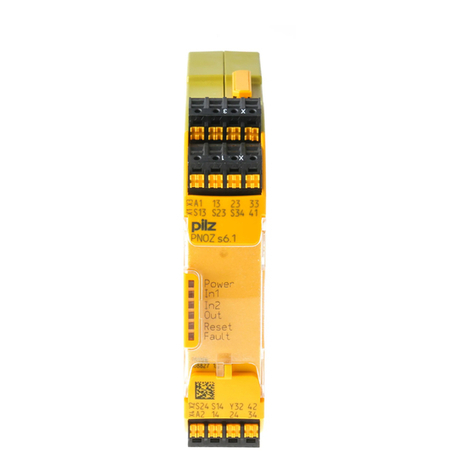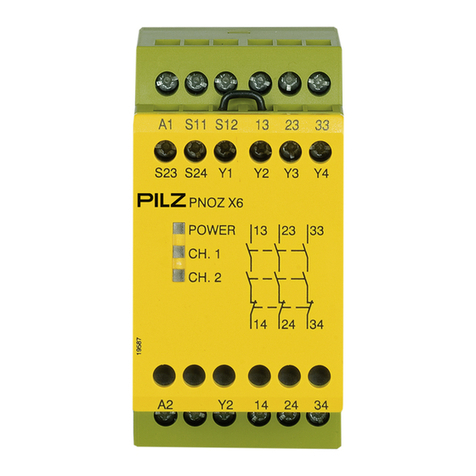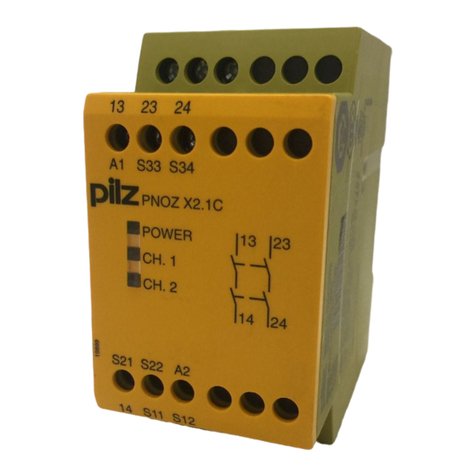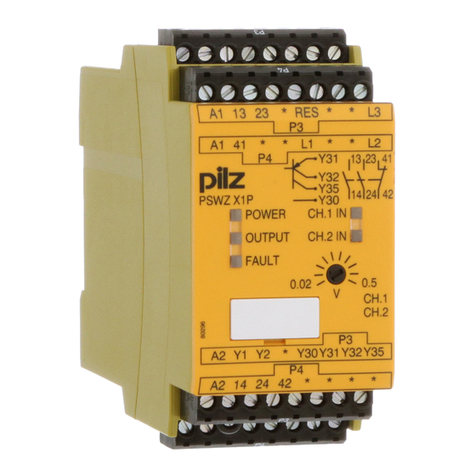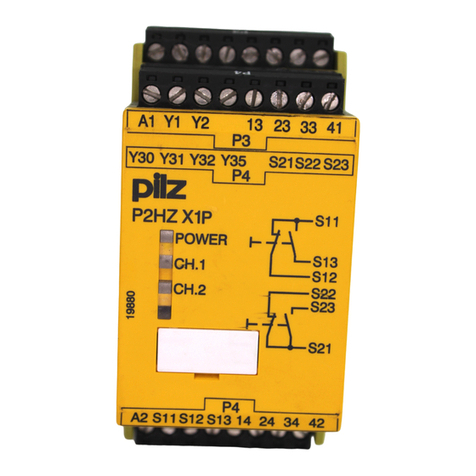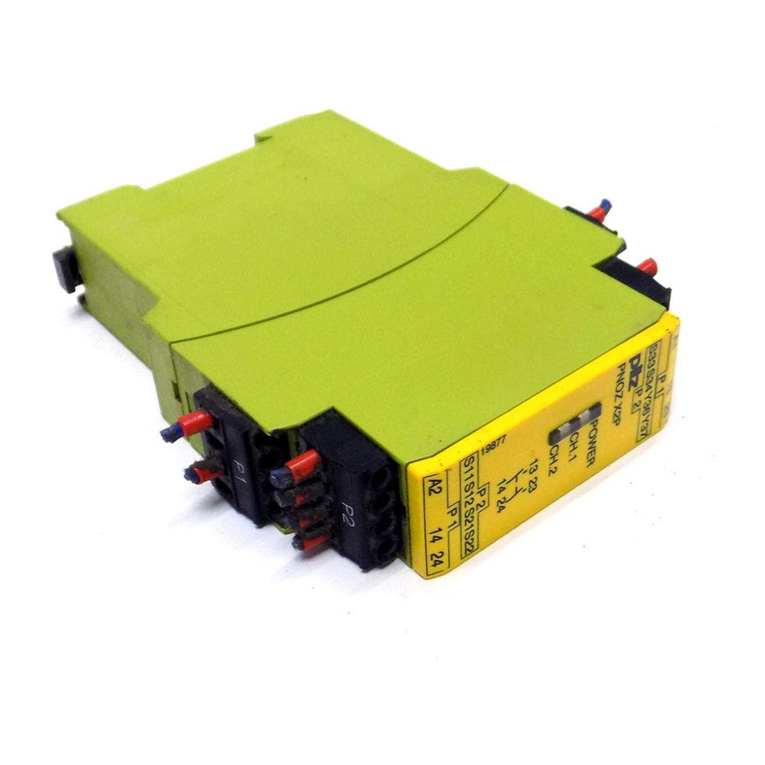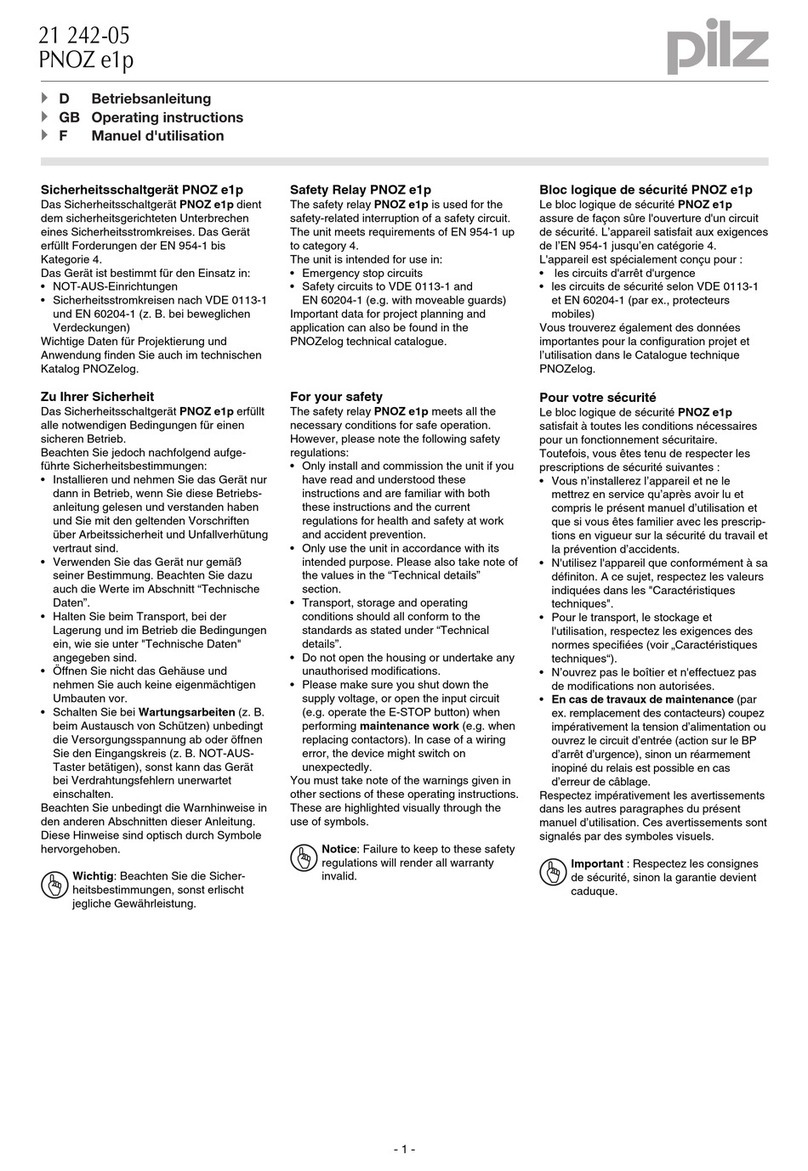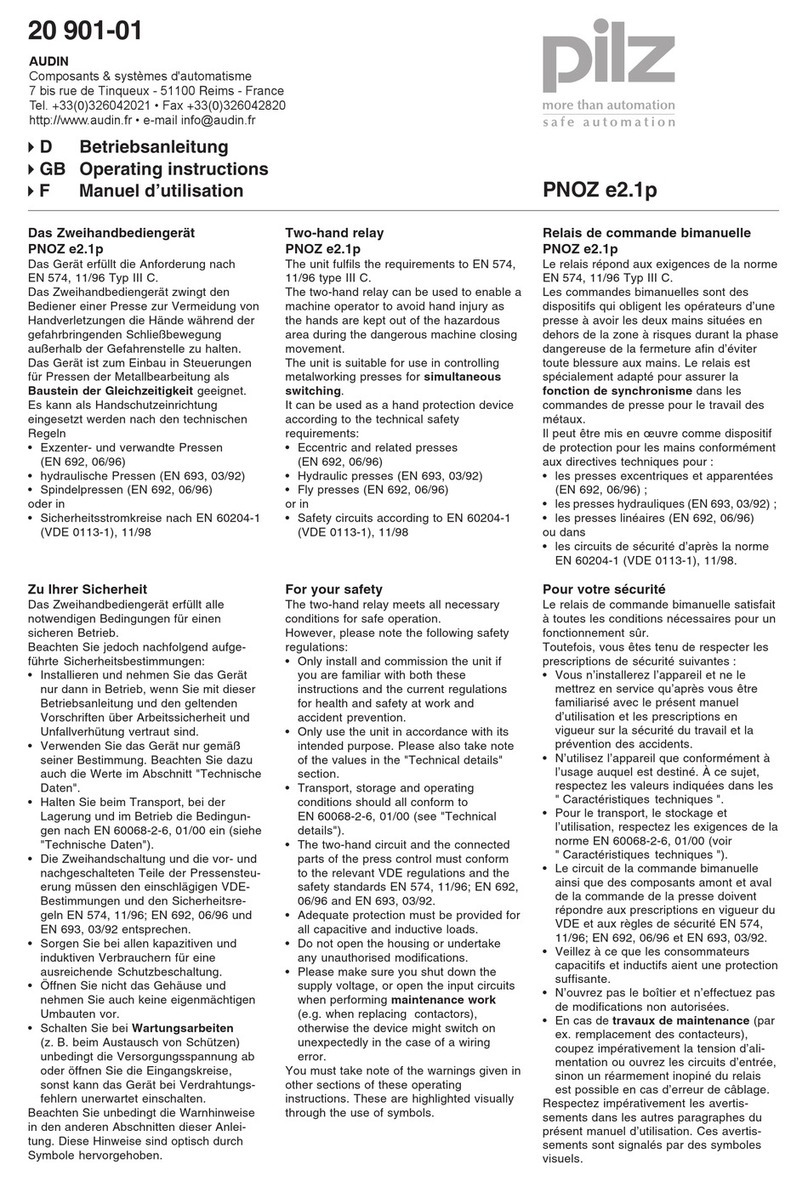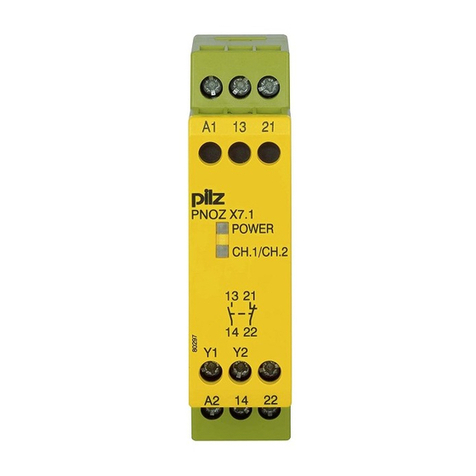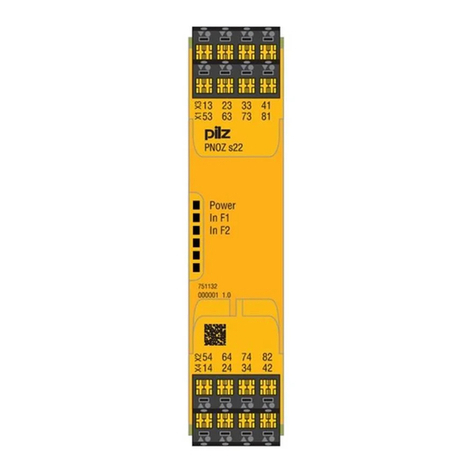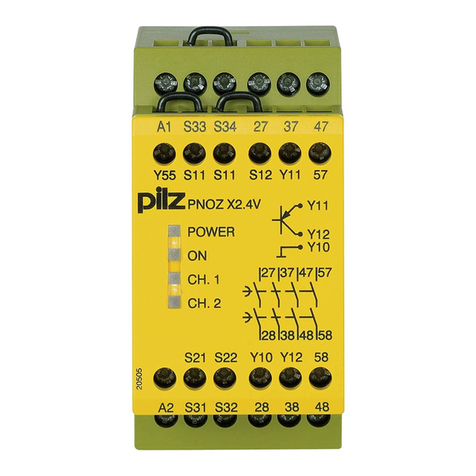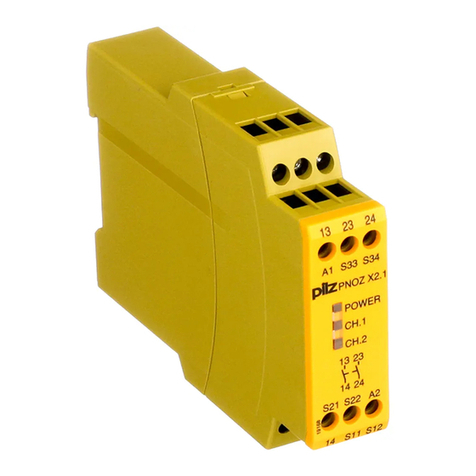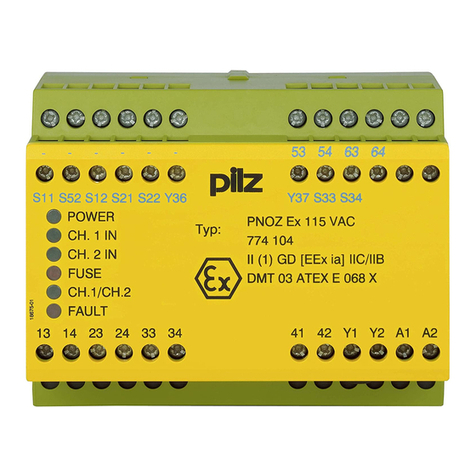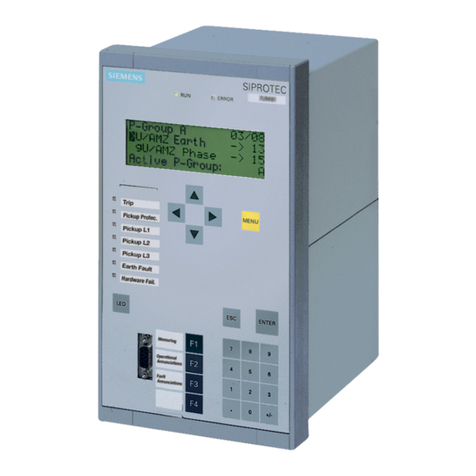
- 4 -
Anschluss
• PNOZ V mit einstellbarer Rückfallverzö-
gerung: Verzögerungszeit für
Sicherheitskontakt 57-58 mit Hilfe eines
Schraubendrehers festlegen.
• Versorgungsspannung an Klemmen A1
(+) und A2 (-) anschließen.
• Eingangskreis: NOT-AUS-Taster oder
Sicherheitsendschalter anschließen:
- Einkanaliger Betrieb: Eingangskreis an
S11 und S12 anschließen; Brücke
zwischen S12-S22 einlegen.
- Zweikanaliger Betrieb: Eingangskreise
an S11, S12 und an S11, S22 an-
schließen.
• Startkreis
- Manueller Start: Startkontakt zwischen
S33 und S34 anschließen.
- Automatischer Start: Brücke an S33-
S34
• Rückführkreis
Öffnerkontakte der zu überwachenden
Schütze am Rückführkreis Y1-Y2
anschließen oder - wenn nicht benötigt -
Brücke Y1-Y2 einlegen.
Ablauf
Das Gerät ist eingeschaltet, wenn
• die Versorgungsspannung anliegt (LED
"Power" leuchtet)
• die Eingangskreise geschlossen sind
• der Startkreis für mind. 150 ms geschlos-
sen wird
Die Sicherheitskontakte 13-14, 23-24,
33-34 und 57-58 sind geschlossen und alle
vier LEDs für "Ch. 1" und "Ch. 2" leuchten.
Der Hilfskontakt 41-42 ist geöffnet. Wird der
Eingangskreis geöffnet, öffnen die
Sicherheitskontakte 13-14, 23-24, 33-34.
Der Hilfskontakt 41-42 schließt wieder. Die
LEDs "Ch.i1" und "Ch. 2" (oben) gehen aus.
Nach Ablauf der Rückfallverzögerung öffnet
der Sicherheitskontakt 57-58 und die LEDs
"Ch.i1" und "Ch. 2" (unten) gehen aus.
Wieder aktivieren
• Eingangskreis schließen.
• Startkreis für mindestens 150 ms
schließen.
Anwendung
In allen Beispielen werden Erdschlüsse
erkannt. Fig. 2 u. 3 sind Beispiele für NOT-
AUS-Stromkreise.
Schutztürsteuerungen (Fig. 4 - 7):
• Schutztürsteuerung 1 (Fig. 4)
- manueller Start mit S2
- einkanaliger Betrieb
- geeignet für Schutztüren, die nur zu
Wartungszwecken geöffnet werden
• Schutztürsteuerung 2 (Fig. 5)
- manueller Start mit S3
- zweikanaliger Betrieb
- geeignet für Schutztüren mit erhöhten
Sicherheitsanforderungen
• Schutztürsteuerung 3 (Fig. 6)
- mit automatischem Start nach dem
Schließen der Schutztüre
- Überwachung der zeitlichen Abfolge
der Grenztaster S1 u. S2 (Differenz tg
der Schaltpunkte ca. 75 ms)
- zweikanaliger Betrieb
- geeignet für Schutztüren mit hohen
Sicherheitsanforderungen
Der Rückführkreis dient zur Überwachung
externer Schütze, die zur Kontakt-
verstärkung oder Vervielfältigung verwen-
det werden (Fig. 7). Eine Kombination mit
den Schaltungen nach Fig. 2 - 6 ist möglich.
Branchement
• PNOZ V avec temporisation réglable:
régler la temporisation du contact 57-58 à
l'aide d'un tournevis
• Ramener la tension d'alimentation (A1/A2)
• Canaux d'entrée :
Câblage de l'interrupteur de position ou
d'Au :
- Commande par un canal : câbler le
circuit d'entrée aux bornes S11 et S12;
ponter les bornes S12-S22.
- Commande par deux canaux : câbler
les canaux d'entrée aux bornes S11,
S12 et aux bornes S11, S22.
• Réarmement :
- Réarmement manuel : câbler le BP de
validation entre les bornes S33 et S34.
- Réarmement automatique : relier les
bornes S33-S34.
• Boucle de retour :
Câbler les contacts à ouverture des
contacteurs à surveiller dans la boucle de
retour Y1-Y2 ou - quand ce n'est pas
nécessaire - relier les bornes Y1-Y2.
Mise en oeuvre
L'appareil est activé lorsque :
• La tension d'alimentation est présente (la
LED "Power" s'allume).
• Le canal d'entrée est fermé.
• Le canal de validation est fermé au moins
150 ms.
Les contacts de sécurité 13-14, 23-24,
33-34 et 57-58 se ferment et les 4 LEDs de
visualisation "Ch. 1" und "Ch. 2" sont allu-
mées. Le contact d'info. 41-42 est ouvert.
Si un des canaux d'entrée est ouvert, les
contacts de sécurité 13-14, 23-24, 33-34
s'ouvrent. Le contact d'info. 41-42 se ferme
et les LEDs "Ch. 1" et "Ch. 2" (du haut)
s'étein-gnent. Au bout de la temporisation, le
contact de sécurité 57-58 s'ouvre et les
LEDs "Ch. 1" et "Ch. 2" (du bas)
s'éteingnent.
Réarmement
• Fermer les canaux d'entrée.
• Fermer le canal de validation au moins
150ims.
Utilisation
Dans tous les exemples, les défauts de
masse sont détectés. Les figures 2 et 3
sont des exemples pour les circuits d'AU.
Dispositifs de verrouillage (fig. 4-7)
• Dispositif de verrouillage 1 (fig. 4)
- Mise en marche manuelle avec S2.
- Commande par un canal.
- Surveillance de protecteurs avec
accès occasionnels à la zone
dangereuse.
• Dispositif de verrouillage 2 (fig. 5)
- Mise en marche manuelle avec S3.
- Commande par deux canaux.
- Surveillance de protecteurs avec un
haut niveau de sécurité.
• Dispositif de verrouillage 3 (fig. 6)
- Réarmement automatique après une
fermeture des capots mobiles.
- Surveillance du désynchronisme entre
les 2 interrupteurs de position S1 et S2
(désynchronisme max. tgenv. 75 ms)
- Commande par deux canaux.
- Surveillance de protecteurs avec un
haut niveau de sécurité.
La boucle de retour sert au contrôle de
contacteurs externes, qui sont utilisés pour
augmenter le pouvoir de coupure ou le
nombre de contacts (fig. 7).
Une combinaison avec les figures 2-6 est
possible.
Connection
• PNOZ V with adjustable delay-on-de-
energisation: Adjust the desired delay
time of contact 57-58, using a
screwdriver
• Connect the operating voltage between
A1i(+) and A2 (-).
• Input circuit
Connect the E-Stop button or safety limit
switch:
- Single channel operation: Connect
input circuit to S11 and S12; bridge
S12-S22.
- Two channel operation: Connect input
circuit to S11, S12 and to S11, S22.
• Reset circuit
- Manual reset: Connect the reset
contact between S33 and S34.
- Automatic reset: Bridge S33-S34.
• Feedback control loop
Connect the N/C contact of the relay to
be monitored to the feedback control loop
Y1-Y2 or - if not needed - bridge Y1-Y2.
To operate
The unit is activated when:
• The operating voltage is supplied (LED
„Power“ is illuminated)
• the input circuits are closed
• the reset contact is closed for a minimum
of 150 ms
The safety contacts 13-14, 23-24, 33-34
and 57-58 are closed and all four LEDs for
"Ch. 1" and "Ch. 2" illuminate. The auxilliary
contact 41-42 is open. If the input circuit is
opened, the safety contacts 13-14, 23-24,
33-34 open. The auxilliary contact 41-42
closes again. The LEDs "Ch. 1" and "Ch. 2"
(upper) extinguish. After the delay-on de-
energisation period has lapsed, the safety
contact 57-58 opens and the LEDs "Ch. 1"
and "Ch. 2" (lower) extinguish.
Reactivation
• Close the input circuits
• Close the reset circuit for a minimum of
150 ms.
Application
Earth faults are detected in all examples.
Fig. 2 and 3 are examples for Emergency
Stop circuits.
Safety gate control (Fig. 4 - 7):
• Safety gate control 1 (Fig. 4)
- manual reset with S2
- single channel operation
- suitable for safety gates only opened
during maintenance
• Safety gate control 2 (Fig. 5)
- manual reset with S3
- two channel operation
- suitable for safety gates with high level
safety requirements
• Safety gate control 3 (Fig. 6)
- automatic reset following closure of the
safety gate
- monitoring of the time sequence of the
limit switches S1 and S2 (delay tgof the
switching points appx. 75 ms)
- two channel operation
- suitable for safety gates with high level
safety requirements
The Feedback control loop is for the
monitoring of external relays to increase the
number of available contacts (Fig. 7). A
combination with the wiring as in Fig. 2 - 6 is
possible.





